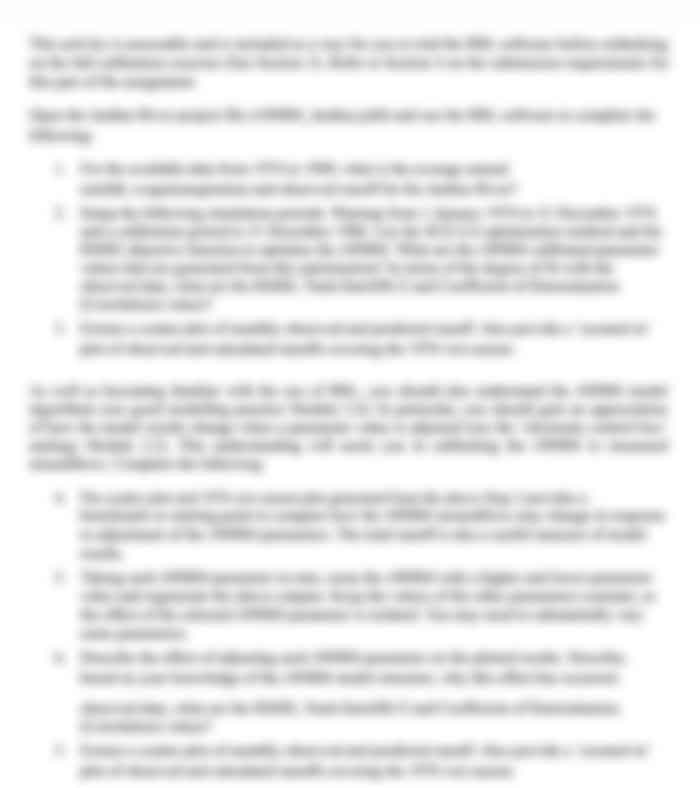Business Administration Programmes
Business Administration Programmes
Assignment 1
Course: BUAD801 Decision Support Tools and Techniques
Lecturer: Ms Sawsan Al-Shamaa
Stream: 223 -224
Due: 4 pm Friday 26 April, 2024 (soft copy submission through Moodle only)
POINTS to NOTE:
There are 100 marks for this assignment which is 25% of the final course grade.
The word limit for this assignment is 2,500 words (+/-10%), excluding references, figures, tables, and appendixes.
Use Arial or Times New Roman font size 12 and 1.5 line spacing.
Ensure you follow academic citation and referencing requirements, as failure to do so may invoke penalties. Use APA (7th ed.). A reference list is required.
You are also required to reference the use of any tools/software/application used. This includes the use of artificial intelligence (AI) to paraphrase or proofread, which requires a statement where applicable.
Upon submission your assignment will be checked for copied materials as well as the use of AI (artificial intelligence), with penalties to be applied where appropriate and if not appropriately referenced.
You may submit your assignment as a draft submission (Moodle/Turnitin) to check similarity prior to making your final submission.
Late submissions incur a 5% penalty (5 marks) for each 24-hour period up to 96 hours (after that time, your mark will be recorded as zero).
An extension may be granted if, within the prescribed timeframe, you submit an 'Assignment Extension Application' form with supporting documentation (e.g., a medical certificate) to the Programme Administration Unit.
As part of pass requirements for this course, you are required to pass each learning outcome at least once in this course.
Learning Outcomes:
As set out in your Course Outline, this assignment requires you to:
LO2 Effectively correlate data to construct various graphs in order to select appropriagte quantitative tools.
LO3 Demonstrates analytical skills for managerial decision-making by evaluating and interpreting business scenarios.; and
LO4 Apply calculations using appropriate instruments to distinguish between using forecasting and regression tools.
BUSINESS SCENARIO
A New Zealand company specialising in distributing goods to consumers is looking to expand its activity internally or externally (outside New Zealand). The management team of this company needs to look at the feasibility of that expansion by using quantitative analysis for some economic indicators. The two alternative scenarios are:
expand in New Zealand; or
establish a new division in another country.
Five economic indicators are selected to analyse and help in making decisions.
GDP per head
Imports goods growth rate
Export good growth rate
Growth rate of GDP private final consumption expenditure
Unemployment population
1415491216293Quarterly data for the period 2016 Q3- 2023 Q3 was extracted from https://stats.oecd.org for each of the above five variables for all OECD countries and made available to you (available on the BUAD801 Moodle page).
You have been asked to select a country (with the approval of your lecturer) and prepare a report using a quantitative analysis approach to help the management in their decision-making.
As part of the report, you are required to:
Create appropriate graphs to correlate the five (5) variables above for the selected country and interpret the graphs you create. Select appropriate quantitative tools and apply them to examine the trend, distribution, and stability for each of the five (5) variables. Provide an interpretation of the results and justify these results in terms of helping decision-making. (20 marks)
Conduct an analysis to look at the relationship between the five (5) above variables for the selected country, interpret the measures that indicate the significance of the analysis, and evaluate the importance of the analysis for the decision-maker. (25 marks)
Forecast for the period (2023Q4 -2025Q3) for each of the five variables and provide an interpretation of the outcomes to support managerial decisions.
(15 marks)
Distinguish between the forecasting method you applied, and the regression analysis used in requirement two using the calculation you performed in the two analyses. (10 marks)
Compare the New Zealand statistical analysis supplied to you (on Moodle as an Excel worksheet in the assessment section) with the statistical analysis for your selected country in terms of the significance of the analysis used in both countries and evaluate the two alternatives scenarios with justification using the quantitative analysis.
Provide management with your outlined recommendation using appropriate statistical language. (25 marks)
Use appropriate academic writing conventions (5 marks)
The Excel worksheet (for the selected country) must be uploaded as a separate file with the raw data table for your selected country.
Grading D- (0% - 39%) D (40% - 49%) C (50% - 64%) B (65% - 79%) A (80% 100%) Correlation and quantitative analysis
LO2 Various graphs were applied but not representing the correlation between the five variables, with no interpretation of the graphs, and the quantitative tools selected to look at the trend, distribution, and stability are not aligned with the graphs, with the inaccurate interpretation of tools with no justification. Incomplete graphs were applied to correlate the five variables, incomplete interpretation for these graphs, and the
Selected quantitative tools are aligned to the trend, distribution, and stability of the variables,
interpretation is done with minor errors and no justification discussed. Various graphs were used clearly to correlate the five variables, a clear interpretation of the graphs. Appropriate quantitative tools were selected to look at the trend, distribution, and stability and aligned with the various graphs for the five variables, and the justification of the result was done clearly. Various graphs are accurately used to correlate the five variables with accurate interpretation of these graphs, leading to the selection of a complete quantitative tool to look at each variable's trend, distribution, and stability. Accurate interpretation of each of these tools with accurate justification. Various graphs are represented to correlate
the five variables with a comprehensive interpretation of each graph leads to applying appropriate quantitative tools to look at the trend, distribution, and stability.
of each variable with a comprehensive interpretation of each tool and comprehensive justification.
Marks out of 20 Student Feedback
Analysis LO3, LO4 Inaccurate analysis was applied to look at the relationship between the five variables, and no interpretation of the measures of the output to look at the significance of the tool.
The importance of the analysis to the decisionmaker is not stated. The analysis and the calculations were applied to look at the relationships for the five variables but were not completed, the
interpretation of the measures missing the significance of the analysis, and the discussion of the importance of the analysis to decision-makers was not stated. The analysis and the calculations were applied clearly and correctly to look at the relationship between the five variables, and the interpretation of the measures of the analysis output clearly stated the significance of the analysis and how it is important for the decision-maker discussed clearly. The analysis and the calculation of the tools to look at the relationship were applied completely to the five variables, a robust interpretation of the output measures that covered what is required for the significance of the analysis. discussion of how important it is for decision-makers stated accurately. A comprehensive analysis and calculations were applied to look at the relationships between the five variables, and an in-depth interpretation of the measures to look at the significance of the analysis.
The importance of the analysis to the decisionmaker was comprehensively stated.
Marks out of 25 Student Feedback
Forecast
LO3, LO4
Inaccurate method to forecast for the period required for each variable, and interpretation of the output includes errors. The required forecast method and calculation for the period required were incomplete for the five variables, and the interpretation of the output was incomplete. The required forecast method and calculations are applied clearly for each variable and the required period, a clear interpretation of the output. An accurate calculation for the required forecast method was applied for the required period and to each variable and the interpretation was linked to the output for each variable. The required forecast method and calculation for the required period for each variable were comprehensively applied, and the interpretation of the output was comprehensively stated for each variable and aligned to the output.
Marks out of 15
Student Feedback
Distinguish
LO4
The differences between the forecasting method applied and the regression analysis are not stated using the performed calculation.
The differences between the applied forecasting method and the regression analysis method used in point two are incomplete and justification is unrelated to the performed calculations. Differences between the forecast method applied and the regression analysis used in point two were clear with minimum justification using the performed calculations.
An accurate difference between the forecasting method applied and the regression analysis applied in point two, justification using the performed calculations accurately applied. Comprehensive differences between the forecasting method identified and discussed with the regression analysis method used in point two and justified using the calculation performed.
Marks out of 10
Student Feedback
Comparison
LO2, LO3
An evaluation of the two business alternatives has been conducted without considering the statistical analysis in the comparison. A recommendation on the alternatives was made not based on the analytical skills performed for the selected country.
The language used in writing the recommendations to the decision-maker is not proper statistical language. An evaluation of the two business alternatives is incomplete.
The statistical analyses that have been considered in the The comparison was incomplete.
A recommendation on the alternative was incomplete in using analytical skills that were performed for the selected country.
Minor errors when using statistical language in the recommendation to the decision-makers. The evaluation of the two business scenarios was conducted using statistical analyses related to the five relevant variables for the country selected The alternative was recommended based on the
analytical skills performed for the selected country and the New Zealand statistical analysis.
Clear statistical language is used in the recommendation to the decision-makers.
A robust evaluation of the two business alternatives has been conducted. All statistical analyses used in the process of
comparison is applied to the five relevant variables.
The recommendation on the alternative was made based on the application of analytical skills performed for the selected country and New Zealand statistical analysis.
Accurate statistical language is used in the recommendation for the decision-makers. A comprehensive evaluation of the two business alternatives has been conducted.
All five variables have been considered, and the selection is feasible based on the data showing great insights with various statistical analysis tools considered.
A detailed and in-depth recommendation on the alternative was made based
on the application of analytical skills performed for the selected country and New Zealand statistical analysis.
Effective statistical language
was used in giving recommendations to decision-makers.
Marks out of 25
Student feedback
Academic writing convention
Academic writing conventions are not followed including formatting, grammar, spelling, and APA 7 referencing. Academic writing conventions are followed inconsistently including formatting, grammar, spelling, and APA 7 referencing.
Academic writing conventions are followed including formatting, grammar, spelling, and APA 7 referencing. Academic writing conventions are followed clearly and consistently including formatting, grammar, spelling, and APA 7 referencing. Academic writing conventions are followed meticulously including formatting, grammar, spelling, and APA 7 referencing.
Marks out of 5 = Student feedback
Learning Outcome Achievement Achieved Yes/No How was the LO achieved or why not?
Learning Outcome 2
Learning Outcome 3
Learning Outcome 4

